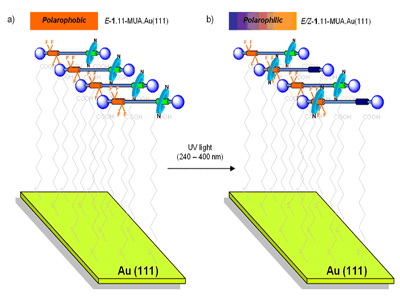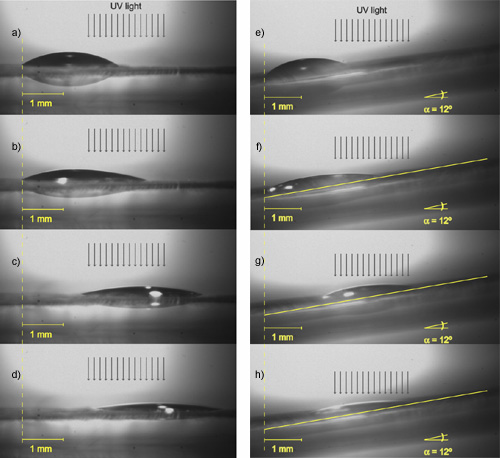Macroscopic Transport by Synthetic Molecular Machines
J Berná, D A Leigh, M Lubomska, S M Mendoza, E M Pérez, P Rudolf, G Teobaldi and F Zerbetto, Nature Mater, 4, 704-710 (2005). Leigh Group Website, Full Article.
(Click image to enlarge)
Nature uses molecular motors and machines in virtually every significant biological process, but demonstrating that artificial structures can be interfaced with – and perform physical tasks in - the macroscopic world represents a significant hurdle for molecular nanotechnology. In a recently published paper the Leigh (University of Edinburgh), Rudolf (University of Groningen) and Zerbetto (University of Bologna) groups describe the first demonstration of the stimuli-induced motion in synthetic molecular machines being used to transport an object and do macroscopic work, using the same mechanism that biology does, namely biasing Brownian motion. A single layer of light-driven molecular shuttles attached to a self-assembled monolayer of thiols on gold (Figure 1) is able to transport microlitre droplets of diiodomethane along the surface - a mechanical macroscopic response from a mechanical molecular event.

Figure 1. A single molecule thick layer of artificial molecular machines on a gold surface. (a) Prior to shining light the surface is ‘Teflon-like’ with the fluorine atoms (F) exposed. (b) After shining UV light, the ring components of the machines move to cover up some of the fluorine atoms and the surface becomes more energetically favourable for liquids deposited on the surface.
The mechanism is that the macrocycle movement of the shuttle is used to either conceal or reveal a fluoroalkane (‘Teflon-like’) residue which dramatically alters the surface tension of the droplet. Not only can this transport a droplet across a flat surface (Figure 2a-d) but it can also be used to the transport of a droplet against gravity, elevating it 1 mm up a 12° slope (Figure 2e-h).

Figure 2. Light-driven directional transport of a 1.25 μl diiodomethane drop across the surface of monolayer of molecular machines, both flat (a)-(d) and up a twelve degree incline (e)-(h). This extrapolation across 6 orders of magnitude in length scales from mechanical motion at the molecular level to macroscopic transport is truly remarkable - the equivalent of millimetre motion of components in a machine working to raise an object to over twice the height of the CN Tower, the world’s tallest building. The work done by the monolayer of molecular machines is stored as potential energy.
The transport phenomenon is not only illustrated by photographs, but is captured in video form:
The transport of liquids by molecular machines could have applications in microfluidics and diagnostic ‘lab-on-a-chip’ type applications. One day, it may even be possible to transport solid objects with a laser pointer using molecular machines!

